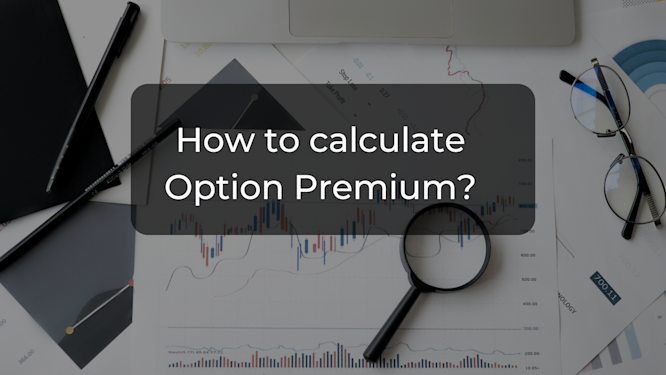How to Calculate Option Premium: A Step-by-Step Guide
Options Trading
In the world of financial derivatives, options trading stands out as one of the most flexible and powerful tools available to investors. Whether you are seeking to hedge risks or speculate on market movements, options provide an opportunity to engage with the underlying asset in a way that goes beyond direct ownership.
One of the most critical components of options trading is understanding the option premium — the price paid by the buyer to acquire an options contract. This premium not only determines the cost of entering an options contract but also plays a vital role in determining the potential profits and losses of the investor involved.
In this blog, we’ll explore the concept of option premiums in depth, how they are calculated, and why they matter for traders. We will also walk through the key factors that influence these premiums, including intrinsic value, extrinsic value, volatility, and time decay, and how these variables affect your trading strategy.
What is an Option Premium?- How to Calculate Option Premium
An option premium is the price that the buyer pays for the right to either buy or sell an underlying asset, without any obligation to do so. It is a non-refundable amount paid at the time the contract is initiated. The buyer of the option can choose to exercise the option before it expires, or let it lapse.
The premium is determined by various factors, including the intrinsic and extrinsic values of the option. The seller, or writer of the option, receives the premium in exchange for taking on the potential obligation to sell or buy the asset at the strike price if the buyer chooses to exercise the option.
Thus, the option premium serves as compensation for the risk assumed by the seller and sets the cost of entering into the options contract.
Components of an Option Premium
Option premiums are composed of two main components:
1. Intrinsic Value
The intrinsic value represents the real value of the option, and it is defined as the difference between the underlying asset’s current price and the strike price of the option. In simple terms, it tells us whether the option has any inherent value based on the price movement of the underlying asset.
For a Call Option: The intrinsic value is calculated by subtracting the strike price from the current price of the underlying asset.
Formula: Intrinsic Value (Call) = Current Asset Price - Strike Price
Example: If a stock is trading at ₹50 and the strike price is ₹45, the intrinsic value is ₹5.
For a Put Option: The intrinsic value is calculated by subtracting the current price of the underlying asset from the strike price.
Formula: Intrinsic Value (Put) = Strike Price - Current Asset Price
Example: If a stock is trading at ₹50 and the strike price is ₹55, the intrinsic value is ₹5.
The intrinsic value of an option can never be negative. If the intrinsic value is negative, it is treated as zero. This happens when an option is out-of-the-money (OTM).
2. Extrinsic Value (Time Value)
The extrinsic value of an option represents the additional amount an investor is willing to pay for the time remaining until expiration and the potential for the option to move in-the-money. It is sometimes referred to as the time value.
The extrinsic value reflects the uncertainty associated with the underlying asset’s price movement. It incorporates the time until expiration, volatility, and interest rates. As expiration approaches, the time value decreases — this is known as time decay.
Extrinsic value can be calculated using the formula:
Extrinsic Value = Option Premium - Intrinsic Value
For example, if an option premium is ₹7 and the intrinsic value is ₹5, the extrinsic value will be ₹2.
Key Factors Influencing Option Premiums - How to Calculate Option Premium
Several factors influence the calculation of option premiums. These factors shape both the intrinsic and extrinsic values and help determine whether a premium is high or low. Understanding these factors is essential for making informed decisions in options trading.
1. Intrinsic Value
As discussed, intrinsic value represents the difference between the option's strike price and the underlying asset's price. An option that is in-the-money (ITM) will have positive intrinsic value, while an option that is out-of-the-money (OTM) or at-the-money (ATM) will have zero intrinsic value.
In-the-Money (ITM): For a call, the asset's price is greater than the strike price; for a put, the asset's price is lower than the strike price.
Out-of-the-Money (OTM): For a call, the asset's price is lower than the strike price; for a put, the asset's price is higher than the strike price.
At-the-Money (ATM): The asset’s price is equal to the strike price.
2. Time to Expiration
The more time left until the expiration of the option, the higher the premium, as there is more potential for the option to move in-the-money. Options with longer expiration dates provide more opportunities for favorable price movements, and as a result, have higher premiums.
However, as expiration approaches, the time value decreases, leading to a phenomenon known as time decay. The rate of time decay accelerates as the expiration date nears.
3. Implied Volatility
Volatility refers to the degree of price fluctuation in the market. Implied volatility reflects the market's expectations for future price movements and is a critical factor influencing option premiums.
When implied volatility is high, the chances of the option expiring in-the-money increase, which increases the option premium. This is because the market anticipates greater price movements in the underlying asset. Conversely, lower implied volatility results in lower premiums as there is less expected price movement.
4. Interest Rates
Interest rates influence the value of options, particularly for longer-term options. Higher interest rates typically lead to a higher premium for call options because the opportunity cost of tying up capital increases. Conversely, put options tend to have lower premiums when interest rates rise.
5. In-the-Money Status
The relationship between the option and the underlying asset significantly impacts the premium. Options that are in-the-money (ITM) generally have higher premiums due to greater demand, as they have intrinsic value. Out-of-the-money (OTM) options, on the other hand, tend to have lower premiums as they lack intrinsic value.
6. Time Until Expiration
Options with longer durations until expiration tend to have higher premiums due to the greater potential for the price of the underlying asset to move favorably. The availability of time for price fluctuations contributes to a higher extrinsic value.
How to Calculate Option Premiums
To understand option premiums, it’s important to know how they are calculated. Here are the general steps for calculating an option premium:
Step 1: Calculate Intrinsic Value
For Call Options: Intrinsic Value = Current Price of Underlying Asset - Strike Price
For Put Options: Intrinsic Value = Strike Price - Current Price of Underlying Asset
If the intrinsic value is negative, it is rounded up to zero.
Step 2: Estimate Extrinsic Value
Extrinsic value is the difference between the option’s total premium and its intrinsic value:
Extrinsic Value = Option Premium - Intrinsic Value
Using the Black-Scholes Model for Advanced Calculation
For a more accurate option premium calculation, especially in complex scenarios, the Black-Scholes Model is commonly used. This model takes into account the following factors:
S: Current price of the underlying asset
K: Strike price of the option
T: Time to expiration (in years)
r: Risk-free interest rate
σ: Implied volatility
The Black-Scholes formula for call options and put options is:
Call Option Price (C) = S * N(d1) - X * e^(-r * T) * N(d2)
Put Option Price (P) = X * e^(-r * T) * N(-d2) - S * N(-d1)
Where N(d1) and N(d2) are cumulative standard normal distribution functions.
Example Calculation of an Option Premium
Let's consider a practical example of a call option to demonstrate the calculation of option premiums:
Current stock price (S): ₹50
Strike price (X): ₹45
Option premium: ₹7
Intrinsic value: ₹50 - ₹45 = ₹5
Extrinsic value: ₹7 - ₹5 = ₹2
Thus, the total option premium is ₹7, composed of ₹5 intrinsic value and ₹2 extrinsic value.
Why Calculating Option Premiums Matters
Understanding how option premiums are calculated is essential for making informed decisions in options trading. Knowing the intrinsic and extrinsic components helps traders evaluate whether the option is priced fairly and if it offers good value relative to the potential risk and reward.
Traders can use this information to:
Assess the fair price of an options contract.
Evaluate profit opportunities based on price movement and volatility.
Manage risks by considering the time value and volatility associated with the option.
Frequently Asked Questions (FAQs)
Can Option Premiums be Calculated Without the Black-Scholes Model?
Yes, you can calculate option premiums manually using intrinsic and extrinsic values. However, the Black-Scholes model provides a more comprehensive approach by factoring in time, volatility, and interest rates.
What is Time Decay in Options Trading?
Time decay refers to the reduction in the value of an option as it approaches expiration. As the expiration date nears, the option’s time value decreases.
Are Call and Put Premiums Always the Same?
No, call and put premiums can vary based on market conditions, implied volatility, time to expiration, and other factors.
How Does Implied Volatility Affect Option Premiums?
Higher implied volatility increases the option’s premium because the market anticipates greater price movements in the underlying asset, making the option more valuable.
Option premiums play a crucial role in options trading, as they determine the cost of entering a contract and the potential for profit or loss. By understanding the components of an option premium, including intrinsic and extrinsic values, and how factors like volatility, time, and interest rates influence pricing, traders can make more informed decisions.
Whether you're a beginner or an experienced investor, mastering option premiums is essential for successfully navigating the derivatives market. With the right knowledge and tools, you can assess the true value of options contracts and enhance your trading strategy.



